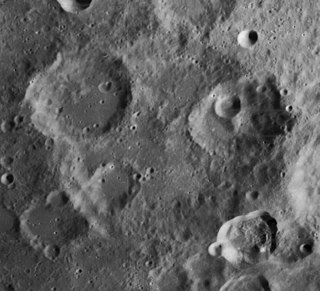
Hommel is a lunar impact crater located in the southeast section of the Moon, in a region that is deeply impacted with a multitude of impact craters. The most notable craters nearby are Pitiscus to the north; Rosenberger due east; and Nearch to the southeast. The prominent crater Vlacq is nearly attached to the northeast rim. Also nearby is Asclepi to the west. Hommel is about 120 kilometers in diameter and its walls reach heights of 2,800 meters. It is from the Pre-Nectarian period, 4.55 to 3.92 billion years ago.

]

Delambre is a lunar impact crater that lies to the southwest of Mare Tranquillitatis, in the central highland region. To the west is the crater pair of Theon Junior and Theon Senior, the latter being more distant and located to the northwest.
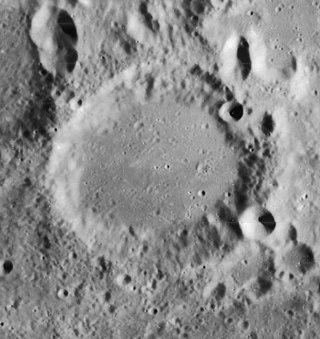
Apianus is a lunar impact crater that is located on the rugged south-central highlands of the Moon. It is named after 16th century German mathematician and astronomer Petrus Apianus. It is located to the northeast of the crater Aliacensis, and to the northwest of Poisson. The worn crater Krusenstern is attached to the west-northwestern rim.

Donati is a lunar impact crater that is located in the rugged south-central highlands of the Moon. It lies just to the northwest of the crater Faye, and the two outer rims are separated by a gap of less than 10 kilometers. To the north is the comparably sized Airy, and farther to the southeast is Playfair. Donati is 36 kilometers in diameter.

Fizeau is a prominent lunar impact crater that is located on the far side of the Moon, in the southern hemisphere. Nearby craters of note include Minkowski to the west-northwest, and Eijkman to the southwest.
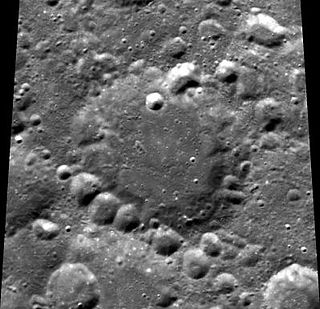
Olivier is an old, eroded crater that is located in the northern hemisphere on the far side of the Moon. It lies in a region of dense cratering on all sides. To the east-southeast is a younger but comparably sized crater named Störmer. Southwest of Olivier is the crater Volterra.

Boltzmann is an old lunar impact crater that is located along the southern limb of the Moon, in the vicinity of the south pole. At this location the crater is viewed from the side from Earth, and so not much detail can be seen. It is located to the north of the walled plain Drygalski, and to the west of the crater Le Gentil.
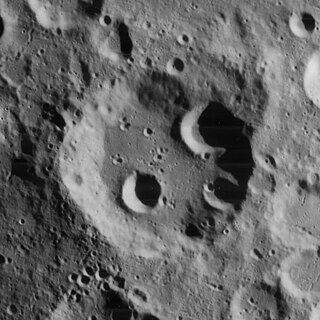
Mutus is a lunar impact crater that is located in the rugged southern part of the Moon. It lies to the north-northeast of the larger crater Manzinus, and some distance to the south of Hommel. It is 78 kilometers in diameter and 3.7 kilometers deep. It is from the Pre-Nectarian period, 4.55 to 3.92 billion years ago.

Deluc is a lunar impact crater that lies in the southern highlands of the Moon. It is located to the south-southeast of the crater Maginus, and the huge Clavius. Due east of Deluc is the somewhat larger crater Lilius. It is 47 kilometers in diameter and 3.3 kilometers deep. It is from the Pre-Imbrian period, which lasted from 4.55 to 3.85 billion years ago.

Curtius is a lunar impact crater that is located in the southern part of the Moon. From the Earth the crater appears foreshortened, making it more difficult to observe detail. Nevertheless, this is a large crater that can be readily found in even small telescopes. Curtius is located within one crater diameter of the still-larger Moretus to the southwest. To the northeast is the smaller Pentland. Curtius is 95 kilometers in diameter and 6.8 kilometers deep. It is from the Nectarian period, 3.92 to 3.85 billion years ago.
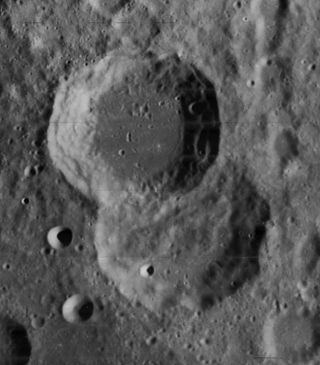
Steinheil is a lunar impact crater that is located in the rugged highlands in the southeastern part of the Moon. It was named after German astronomer and physicist Carl August von Steinheil. It forms a prominent crater pair with the similar-sized Watt, which it partly overlies to the southeast. To the northwest is the large walled plain Janssen. Due to the location of this crater, it appears foreshortened when viewed from the Earth. It is from the Nectarian period, 3.92 to 3.85 billion years ago.

Mee is a lunar impact crater in the southwestern part of the Moon's near side. Overlying the northwestern rim and intruding one-third the distance across the interior floor is Hainzel, a merged triple-crater formation. To the south is the highly elongated crater Schiller. Mee is 132 kilometers in diameter and 2.7 kilometers deep. It is from the Pre-Nectarian period, 4.55 to 3.92 billion years ago.

Licetus is a lunar impact crater on the near side of the Moon, in the rugged southern highland region. It lies to the south of the walled plain Stöfler, and is attached to the northern rim of the sub-divided crater Heraclitus. Just to the southeast is Cuvier. Licetus is 75 kilometers in diameter and 3.8 kilometers deep. It is from the Pre-Nectarian period, 4.55 to 3.92 billion years ago.
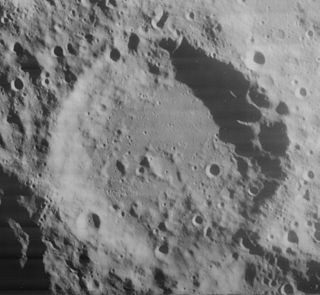
Helmholtz is a lunar impact crater, approximately 110 kilometers in diameter, that is located near the south-southeast limb of the Moon. Attached to the south-southeast rim of Helmholtz is the somewhat smaller crater Neumayer. The larger crater Boussingault is nearly attached to the west-southwestern rim. The crater is named after German physicist and physician Hermann von Helmholtz

Dyson is a lunar impact crater, 63 kilometers in diameter, that lies on the far side of the Moon, past the northwest limb. It is located in the northern part of the surface, to the northwest of the crater Coulomb, and east of van't Hoff.

Nearch is a lunar impact crater that is located in the southeastern part of the Moon, to the southeast of the crater Hommel. North of Nearch is Vlacq, and to the northeast lies Rosenberger. The crater is 76 kilometers in diameter and 2.9 kilometers deep. It is from the Pre-Nectarian period, 4.55 to 3.92 billion years ago.
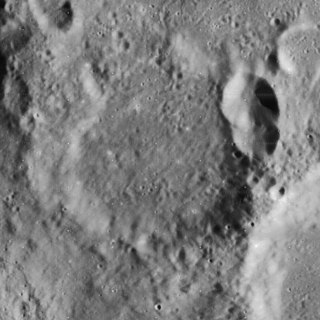
Krusenstern is a lunar impact crater that lies amidst the battered terrain in the southern part of the Moon's near side. Nearly attached to the east-southeast rim is the crater Apianus. Less than one crater diameter to the southwest is the prominent Werner. Krusenstern is intruding into a large circular plain to the north designated Playfair G. Playfair itself lies to the northeast.

Kinau is a small, eroded lunar impact crater that is located in the low southern latitudes of the Moon. It lies to the southeast of the crater Jacobi, and about equally far to the north-northwest of Pentland. It is 42 kilometers in diameter and two kilometers deep. It may be from the Pre-Nectarian period, 4.55 to 3.85 billion years ago.

Donner is a lunar impact crater on the far side of the Moon. It is located just to the northeast of the Mare Australe, behind the southeastern limb of the Moon. During favorable librations this part of the lunar surface can be brought into view of the Earth, but the site is viewed from the edge and so not much detail can be seen.





















